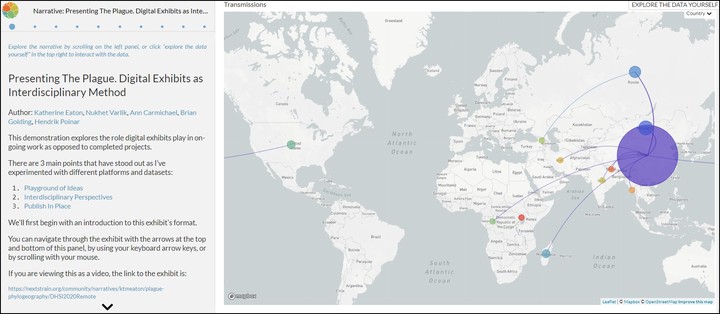Presenting “The Plague”: Digital Exhibits as Interdisciplinary Method
Abstract
The ‘Plague’ is a puzzling and devastating disease that re-emerges throughout history, resulting in extensive mortality and societal upheaval. Given plague’s expansive impact, from the Black Death (14th century) to the Madagascar Plague Outbreak (2017), this disease frequently brings together researchers from disparate disciplines. However, amongst the nuances of disciplines emerges a fascination and convergence around the questions of where, when, and why this disease appears, as well as how the people were affected and coped. Some outstanding questions, and thus exciting avenues of research, include: Where did the medieval plagues originate? When might modern plague foci re-activate? Why is Europe one of the few places where plague no longer exists? And finally, how does a city respond to losing 50% of its population?
Exploring such complex and broad questions requires an interdisciplinary approach that draws upon the collective expertise of researchers from the humanities and sciences. With such unique intersections of theory and method, comes a need for a similarly unique process of sharing and synthesizing research. Digital Humanities methods, particularly the creation of digital exhibits, promises an opportunity to not only publish in more accessible formats, but to explore new ways of conducting collaborative research.
The digital exhibit proposed for the Conference and Colloquium is a NextStrain Narrative. This digital narrative, similar to the StoryMap format, weaves together diverse datasets to drive interactive storytelling. A NextStrain Narrative presents epidemiological data connecting outbreaks (evolutionary trees) alongside maps, timelines, and text descriptions. Specifically, this proposed exhibit presents new interpretations of DNA evidence recovered from plague outbreaks, both past and present. The interactive nature of the exhibit encourages “play” and exploration, inviting new questions to be asked as viewers might, for example, search for spatial and temporal patterns in maps. The ability to simultaneously visualize data generated from different disciplines is a crucial development, as diverse theories are more easily drawn upon to interpret the evidence. It is therefore the intent of this digital demonstration to 1) highlight the work done thus far and seek feedback, and 2) to offer meaningful commentary on the role of digital exhibits not just as scholarly product, but as method in interdisciplinary research.
